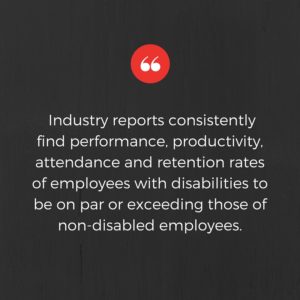POP QUIZ: What is the largest minority group in the country? People with disabilities.
This heterogeneous group makes up 20% of the U.S. population[i], and it is one diversity segment that many people will join throughout the course of their lifetime. Why then does this diversity segment report the highest rate of under and unemployment, with fewer than one in five people with disabilities employed?[ii]
It is not for lack of talent or skill: industry reports consistently find performance, productivity, attendance and retention rates of employees with disabilities to be on par or exceeding those of non-disabled employees.[iii]

In addition, new rules updating Section 503 of the Rehabilitation Act of 1973, from the Office of Federal Contract Compliance Programs at the U.S. Dept. of Labor, require federal contractors to undertake appropriate outreach and positive recruitment activities to meet a “utilization goal” of individuals with disabilities totaling 7% of their workforce.
Many of DirectEmployers Member companies have already realized that disability-inclusion benefits a business’ bottom-line, by:
- Answering concerns about labor supply and satisfying workforce planning strategies by accessing previously untapped talent resources
- Reaping the benefits of important critical thinking skills that people with disabilities develop to adapt to a non-disabled world[iv]
- Tapping into a rich consumer market—people with disabilities have a combined income of more than $1 trillion and $544 billion in discretionary income in the US alone[v]
To meet the demand for disability-employment initiatives, especially among federal contractors, the National Organization on Disability (NOD) partners with businesses to develop successful recruitment and retention strategies to include talent with disabilities in the workforce.
Their 30+ years of experience in providing employment solutions to corporate America, has enabled NOD to develop a toolkit of leading practices that ensure disability-hiring efforts are successful.
How do your company’s policies and practices stack up?
- Does your diversity policy specifically reference individuals with disabilities?
- Do you have employee resource or affinity groups that address disability along with other diverse populations?
- Do your senior leaders discuss and promote disability initiatives?
- Do you offer application and recruitment materials in a variety of accessible formats? Steps like providing application materials in alternative formats (like Braille or large font), asking candidates whether they require accommodations for their interviews, and making sure the company’s website is accessible can go a long way in making candidates with disabilities feel welcomed.
- Do you offer specialized training to recruiters and hiring managers on relating to and addressing the needs of candidates with disabilities?
- Do you have a procedure in place to invite employees and new hires to voluntarily self-identify as an individual with a disability?
- Do you have agreements with placing or sourcing agencies, or career offices at colleges and universities to identify talent with disabilities?
- Do you offer annual disability and diversity training to managers, supervisors and staff?
- Do you track disability status in your human resources information system/database?
- Do you have a comprehensive strategy to promote disability employment within your company?
Disability-inclusion is no longer territory for just the early adopters of the latest diversity and inclusion initiatives. Now is a vital time to evaluate your internal practices and reap the rewards employees with disabilities can bring to your business.
For specialized disability-employment services, or to confidentially assess your company’s practices through the Disability Employment TrackerTM, contact the National Organization on Disability and learn how they can provide comprehensive and successful solutions for your business:
info@nod.org
www.nod.org/business
[i] http://www.sirota.com/PDF/Sirota-NOD%202011%20Employees%20with%20Disabilities%20the%20Forgotten%20Diversity%20Segment%20.pdf
[iii] Darlene Unger, “Employers’ Attitudes Towards People with Disabilities in the Workforce: Myths or Realities,” Employers’ Views of Workplace Supports: Virginia Commonwealth University Charter Business Roundtable’s National Study of Employers’ Experiences with Workers with Disabilities. Edited by Darlene Unger et al., September 2002.
Darlene Unger, “How Do Front-Line Supervisors in Business Perceive the Performance of Workers with Disabilities?” Employers’ Views of Workplace Supports: Virginia Commonwealth University Charter Business Roundtable’s National Study of Employers’ Experiences with Workers with Disabilities, A Study Guide for Human Resource Managers. Edited by Jennifer Todd McDonough et al., May 2002, 23.
[iv] http://www.adawipartnership.org/Resources/DispellingtheMyths.pdf
